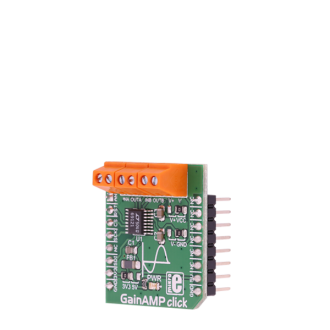
We strongly encourage users to use Package manager for sharing their code on Libstock website, because it boosts your efficiency and leaves the end user with no room for error. [more info]

Rating:
Author: MIKROE
Last Updated: 2018-08-31
Package Version: 1.0.0.1
mikroSDK Library: 1.0.0.0
Category: Amplifier
Downloaded: 5738 times
Not followed.
License: MIT license
GainAMP click carries the LTC®6912 dual channel, low noise, digitally programmable gain amplifier (PGA). The click is designed to work on either 3.3V or 5V power supply. It communicates with the target MCU over SPI interface, with additional functionality provided by the following pins on the mikroBUS line: AN, RST.
Do you want to subscribe in order to receive notifications regarding "GainAMP click" changes.
Do you want to unsubscribe in order to stop receiving notifications regarding "GainAMP click" changes.
Do you want to report abuse regarding "GainAMP click".
